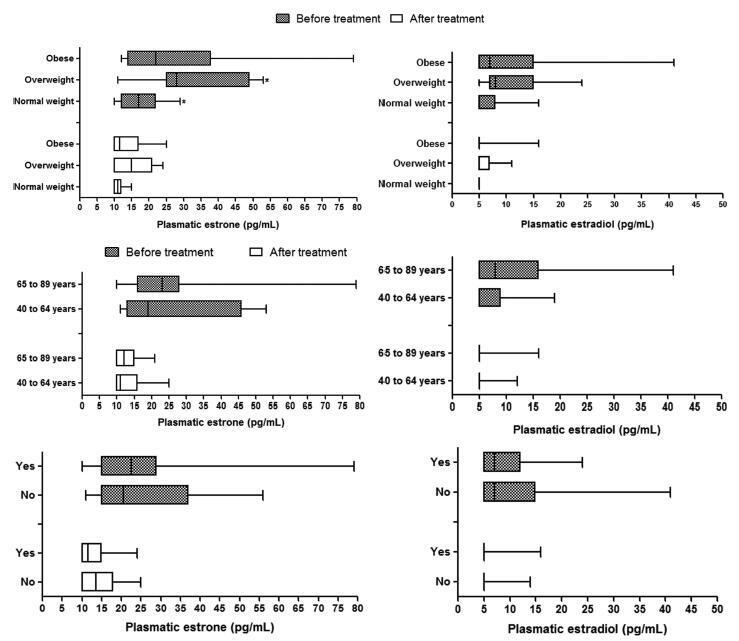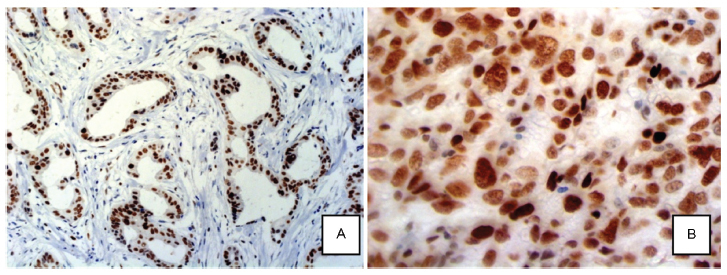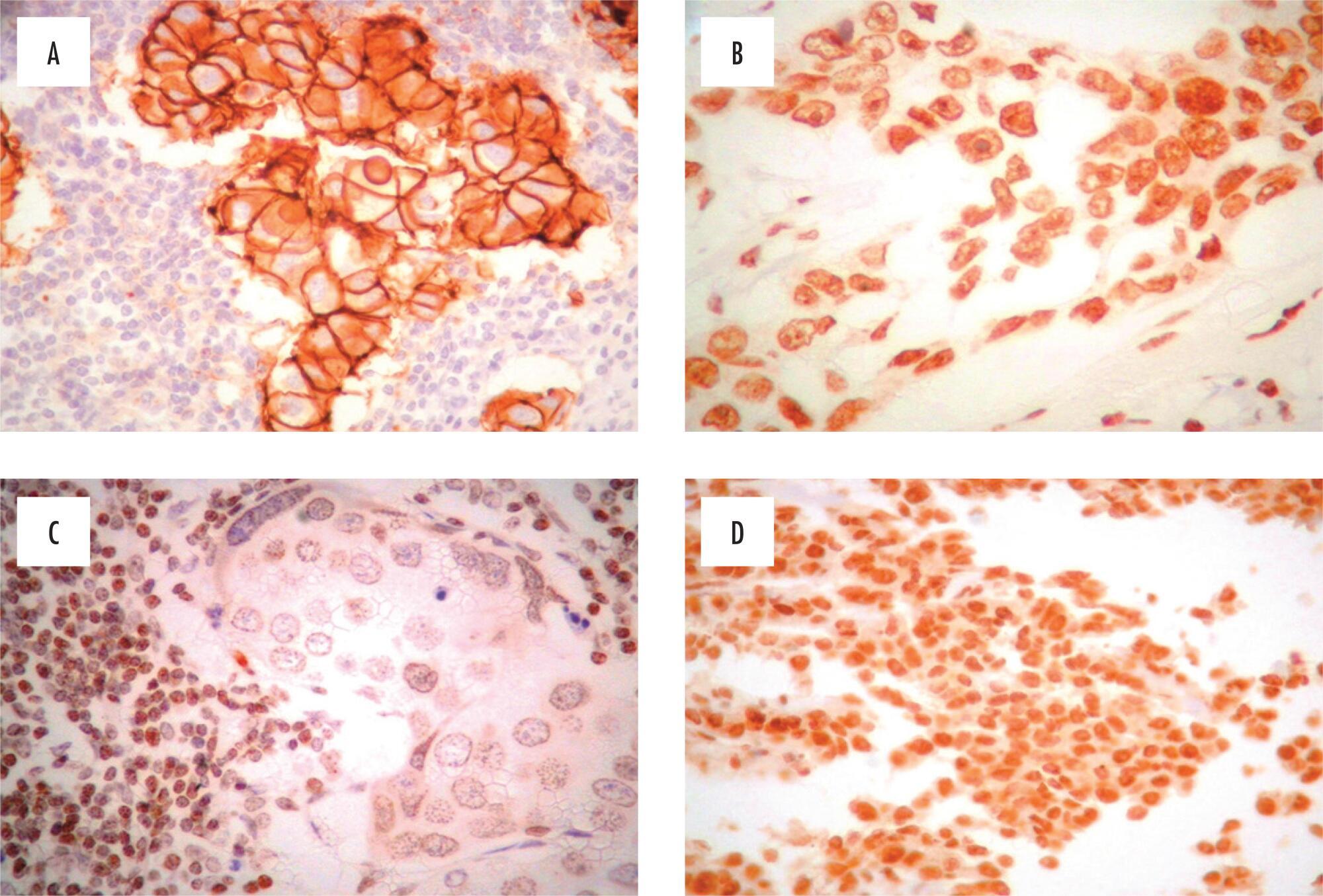-
Original Article01-01-2017
Estrone and Estradiol Levels in Breast Cancer Patients Using Anastrozole Are Not Related to Body Mass Index
Revista Brasileira de Ginecologia e Obstetrícia. 2017;39(1):14-20
Abstract
Original ArticleEstrone and Estradiol Levels in Breast Cancer Patients Using Anastrozole Are Not Related to Body Mass Index
Revista Brasileira de Ginecologia e Obstetrícia. 2017;39(1):14-20
Views172See moreABSTRACT
Objective:
Obesity is associated with an increased risk for breast cancer. Recent studies have shown that aromatase inhibitors may be less effective in women with a high body mass index (BMI). The aim of this study was to establish the relationship between the BMI and plasma estrone and estradiol levels in postmenopausal women with hormone receptor-positive breast cancer using anastrozole.
Methods:
In this cohort study, the patients were divided into three groups according to BMI (normal weight, overweight and obese) to compare and correlate plasma hormone levels before starting anastrozole hormone therapy and three months after treatment. Plasma hormone levels were compared for age and use of chemotherapy.
Results:
A statistically significant reduction in estrone and estradiol levels was observed between baseline and three months after starting the anastrozole treatment (p < 0.05). There was no statistically significant difference in plasma estrone and estradiol levels among the BMI groups (p > 0.05), but a significant reduction in plasma estrone levels was observed after three-months' treatment relative to baseline in all groups, as well as a reduction in estradiol in the obese group (p < 0.05). The use of chemotherapy and age > 65 years had no influence on plasma steroid levels.
Conclusion:
Changes in estrone and estradiol levels in the studied groups were not associated with BMI, chemotherapy or age.

-
Original Article06-01-2016
EZH2 Protein Expression and Tumor Response to Neoadjuvant Chemotherapy in Locally Advanced Breast Cancer
Revista Brasileira de Ginecologia e Obstetrícia. 2016;38(6):280-286
Abstract
Original ArticleEZH2 Protein Expression and Tumor Response to Neoadjuvant Chemotherapy in Locally Advanced Breast Cancer
Revista Brasileira de Ginecologia e Obstetrícia. 2016;38(6):280-286
Views188See moreAbstract
Introduction
Neoadjuvant chemotherapy (NAC) is the standard treatment for locally advanced breast cancer. However, some tumors will not respond to this treatment due to histological and molecular features. The protein EZH2 (enhancer of zest homolog 2) is a histone methyltransferase that is correlated with poorly differentiated breast carcinomas and aggressive tumor behavior.
Purpose
The present study evaluated the association between EZH2 expression and response to NAC, and its correlation with HER2 overexpression, estrogen and progesterone receptors (ER, PR) and Ki-67 proliferation index.
Methods
A total of 60 patients with locally advanced breast cancer treated with NAC were selected for this study. Twenty-three paraffin blocks had not enough material for tissue resection, and were not evaluated. A tissue microarray based in immunohistochemistry (IHC) analysis of EZH2 was performed for the remaining 37 specimens. Patients were divided into two groups based on response to NAC.
Results
EZH2 expression was significantly associated with markers of poor prognosis such as ER negativity (p = 0.001), PR negativity (p = 0.042) and high Ki-67 proliferation index (p = 0.002). High EZH2 expression was not correlated with the response to NAC.
Conclusions
Our data suggested that EZH2 protein expression may not correlate with the clinical response to NAC. Other studies with more patients are needed to confirm this observation.

-
Original Article10-01-2015
Validation of Body Image Relationship Scale for women with breast cancer
Revista Brasileira de Ginecologia e Obstetrícia. 2015;37(10):473-479
Abstract
Original ArticleValidation of Body Image Relationship Scale for women with breast cancer
Revista Brasileira de Ginecologia e Obstetrícia. 2015;37(10):473-479
DOI 10.1590/SO100-720320150005354
Views71See moreAbstract
PURPOSE
To validate the instrument Body Image Relationship Scale (BIRS) for Brazilian women with breast cancer
METHODS
The instrument was administered by trained interviewers to 139 women who used the Brazilian Unified Health System (SUS). All of them had been submitted to cancer treatments between 2006 and 2010. The instrument was validated considering internal consistency and reliability. In order to compare the techniques, the same factorial analysis as used in the original paper was carried out
RESULTS
The Spearman-Brown correlation value was 0.8, indicating high internal reliability. The Cronbach's alpha found was 0.9, indicating a high level of internal consistency. Factorial analysis showed that four items had low factorial load and no discriminatory power, and another five items were relocated to other factors. When the instrument was applied, it showed variability to that of the original instrument
CONCLUSION
The Brazilian version of the Body Image Relationship Scale (BIRS), namedEscala de Relacionamento e Imagem Corporal (ERIC), showed evidence of adequate reliability and internal consistency, making this instrument suitable to be recommended for application to Brazilian women with breast cancer, despite some limitations.
-
Original Article05-01-2015
Effects of tibolone on the breast parenchyma: experimental study
Revista Brasileira de Ginecologia e Obstetrícia. 2015;37(5):233-240
Abstract
Original ArticleEffects of tibolone on the breast parenchyma: experimental study
Revista Brasileira de Ginecologia e Obstetrícia. 2015;37(5):233-240
DOI 10.1590/SO100-720320150005333
Views106OBJECTIVE:
To assess the effect of tibolone on mammary tissue of castrated rats over 3
different periods of time.METHODS:
Sixty virgin female Wistar rats were submitted to oophorectomy. Twenty-one days
after surgery, with hypoestrogenism confirmed, the experimental rats were randomly
assigned to six groups: Tibolone 1 (n=10) received tibolone 1 mg/day for 23 days,
tibolone 2 (n=10) for 59 days and tibolone 3 (n=10) for 118 days. The groups
control 1 (n=8), control 2 (n=7) and control 2 (n=10) received distilled water for
23, 59 and 118 days, respectively. After treatment, all six pairs of mammary
glands were removed and stained with hematoxylin and eosin (HE) for histological
analysis after euthanasia. The histological parameters evaluated were: epithelial
cell proliferation and secretory activity. The variables were analyzed
statistically, with the level of significance set at 0.05.RESULTS:
Histological changes were observed in 20/55 rats, mild epithelial hyperplasia in
7/55, moderate epithelial hyperplasia in 5/55, alveolar-nodular hyperplasia in
7/55, atypia without epithelial proliferation in 1/55, and no cases of severe
epithelial hyperplasia were found. Secretory activity was observed in 31/55 rats.
The secretory activity was significantly higher in the tibolone groups compared to
control at all the time points assessed (p=0,001). The histological changes were
did not show significance when the control and tibolone groups were compared. The
time of exposure to tibolone did not show significance when the three different
periods of evaluation were compared.CONCLUSION:
No relation between histological modification and tibolone treatment was verified
after short-, medium- and long-term treatment.Key-words Breast neoplasmsCell proliferationEstrogens/therapeutic useHormone replacement therapyHyperplasiaRatsTiboloneSee more -
Original Article03-01-2015
Fatigue and quality of life in breast cancer survivors: a comparative study
Revista Brasileira de Ginecologia e Obstetrícia. 2015;37(3):119-126
Abstract
Original ArticleFatigue and quality of life in breast cancer survivors: a comparative study
Revista Brasileira de Ginecologia e Obstetrícia. 2015;37(3):119-126
DOI 10.1590/SO100-720320150005247
Views86See morePURPOSE:
To assess fatigue and quality of life in disease-free breast cancer survivors in relation to a sample of age-matched women with no cancer history and to explore the relationship between fatigue and quality of life.
METHODS:
A cross-sectional study was conducted in a sample of 202 consecutive disease-free Brazilian breast cancer survivors, all of whom had completed treatment, treated at 2 large hospitals. The patients were compared to age-matched women with no cancer history attending a primary health care center. The Piper Fatigue Scale-Revised and the World Health Organization Quality of Life Instrument (WHOQOL-BREF) were used to measure the fatigue and quality of life, respectively. Socio-demographic and clinical variables were also obtained. The χ2 test, generalized linear model, and Spearman correlation coefficient were used for statistical purposes. The adopted level of significance was 5%.
RESULTS:
Breast cancer survivors experienced significantly greater total and subscale fatigue scores than comparison group (all p-values<0.05). In addition, survivors reported a poorer quality of life in physical (p=0.002), psychological (p=0.03), and social relationships (p=0.03) domains than comparison group. No difference was found for the environmental domain (p=0.08) for both groups. For survivors of breast cancer and for comparison group, the total and subscale fatigue scores were related to lower quality of life (all p-values<0.01).
CONCLUSION:
The findings of this study highlight the importance of assessing fatigue and quality of life in breast cancer survivors.
-
Original Article12-01-2014
The new classification of breast cancers: finding the luminal A
Revista Brasileira de Ginecologia e Obstetrícia. 2014;36(12):575-580
Abstract
Original ArticleThe new classification of breast cancers: finding the luminal A
Revista Brasileira de Ginecologia e Obstetrícia. 2014;36(12):575-580
DOI 10.1590/SO100-720320140005158
Views137See morePURPOSE:
To compare the distributions of patients with clinical-pathological subtypes of luminal B-like breast cancer according to the 2011 and 2013 St. Gallen International Breast Cancer Conference Expert Panel.
METHODS:
We studied 142 women with breast cancer who were positive to estrogen receptor and had been treated in São Paulo state, southeast Brazil. The expression of the following receptors was assessed by immunohistochemistry: estrogen, progesterone (PR) and Ki-67. The expression of HER-2 was measured by fluorescent in situ hybridization analysis in tissue microarray.
RESULTS:
There were 29 cases of luminal A breast cancers according to the 2011 St. Gallen International Breast Cancer Conference Expert Panel that were classified as luminal B-like in the 2013 version. Among the 65 luminal B-like breast cancer cases, 29 (45%) were previous luminal A tumors, 15 cases (20%) had a Ki-67 >14% and were at least 20% PR positive and 21 cases (35%) had Ki-67 >14% and more than 20% were PR positive.
CONCLUSIONS:
The 2013 St. Gallen consensus updated the definition of intrinsic molecular subtypes and increased the number of patients classified as having luminal B-like breast cancer in our series, for whom the use of cytotoxic drugs will probably be proposed with additional treatment cost.
-
Original Article08-01-2014
Loss of PTEN expression and AKT activation in HER2-positive breast carcinomas
Revista Brasileira de Ginecologia e Obstetrícia. 2014;36(8):340-346
Abstract
Original ArticleLoss of PTEN expression and AKT activation in HER2-positive breast carcinomas
Revista Brasileira de Ginecologia e Obstetrícia. 2014;36(8):340-346
DOI 10.1509/SO100-720320140005034
Views110PURPOSE:
To examine the expression of AKT and PTEN in a series of HER2-positive primary invasive breast tumors using immunohistochemistry, and to associate these expression profiles with classic pathologic features such as tumor grade, hormone receptor expression, lymphatic vascular invasion, and proliferation.
METHODS:
A total of 104 HER2-positive breast carcinoma specimens were prepared in tissue microarrays blocks for immunohistochemical detection of PTEN and phosphorylated AKT (pAKT). Original histologic sections were reviewed to assess pathological features, including HER2 status and Ki-67 index values. The associations between categorical and numeric variables were identified using Pearson's chi-square test and the Mann-Whitney, respectively.
RESULTS:
Co-expression of pAKT and PTEN was presented in 59 (56.7%) cases. Reduced levels of PTEN expression were detected in 20 (19.2%) cases, and these 20 tumors had a lower Ki-67 index value. In contrast, tumors positive for pAKT expression [71 (68.3%)] were associated with a higher Ki-67 index value.
CONCLUSION:
A role for AKT in the proliferation of HER2-positive breast cancers was confirmed. However, immunohistochemical detection of PTEN expression did not correlate with an inhibition of cellular proliferation or control of AKT phosphorylation, suggesting other pathways in these mechanisms of control.
Key-words Breast neoplasmsGenes, erbB-2Immunohistochemistry PTEN phosphohydrolaseOncogene protein v-aktSee more
-
Original Article03-25-2014
Cardiovascular risk in middle-aged breast cancer survivors: a comparison between two risk models
Revista Brasileira de Ginecologia e Obstetrícia. 2014;36(4):157-162
Abstract
Original ArticleCardiovascular risk in middle-aged breast cancer survivors: a comparison between two risk models
Revista Brasileira de Ginecologia e Obstetrícia. 2014;36(4):157-162
DOI 10.1590/S0100-720320140050.0002
Views95PURPOSE:
It was to assess the risk of cardiovascular disease (CVD) in breast cancer survivors (BCS).
METHODS:
This cross-sectional study analyzed 67 BCS, aged 45 -65 years, who underwent complete oncological treatment, but had not received hormone therapy, tamoxifen or aromatase inhibitors during the previous 6 months. Lipid profile and CVD risk were evaluated, the latter using the Framingham and Systematic COronary Risk Evaluation (SCORE) models. The agreement between cardiovascular risk models was analyzed by calculating a kappa coefficient and its 95% confidence interval (CI).
RESULTS:
Mean subject age was 53.2±6.0 years, with rates of obesity, hypertension, and dyslipidemia of 25, 34 and 90%, respectively. The most frequent lipid abnormalities were high total cholesterol (70%), high LDL-C (51%) and high non-HDL-C (48%) concentrations. Based on the Framingham score, 22% of the participants had a high risk for coronary artery disease. According to the SCORE model, 100 and 93% of the participants were at low risk for fatal CVD in populations at low and high risk, respectively, for CVD. The agreement between the Framingham and SCORE risk models was poor (kappa: 0.1; 95%CI 0.01 -0.2) for populations at high risk for CVD.
CONCLUSIONS:
These findings indicate the need to include lipid profile and CVD risk assessment in the follow-up of BCS, focusing on adequate control of serum lipid concentrations.
Key-words Breast neoplasmsCardiovascular diseasesCoronary artery diseaseDyslipidemiasHypertensionModels, cardiovascularRadiotherapySee more


